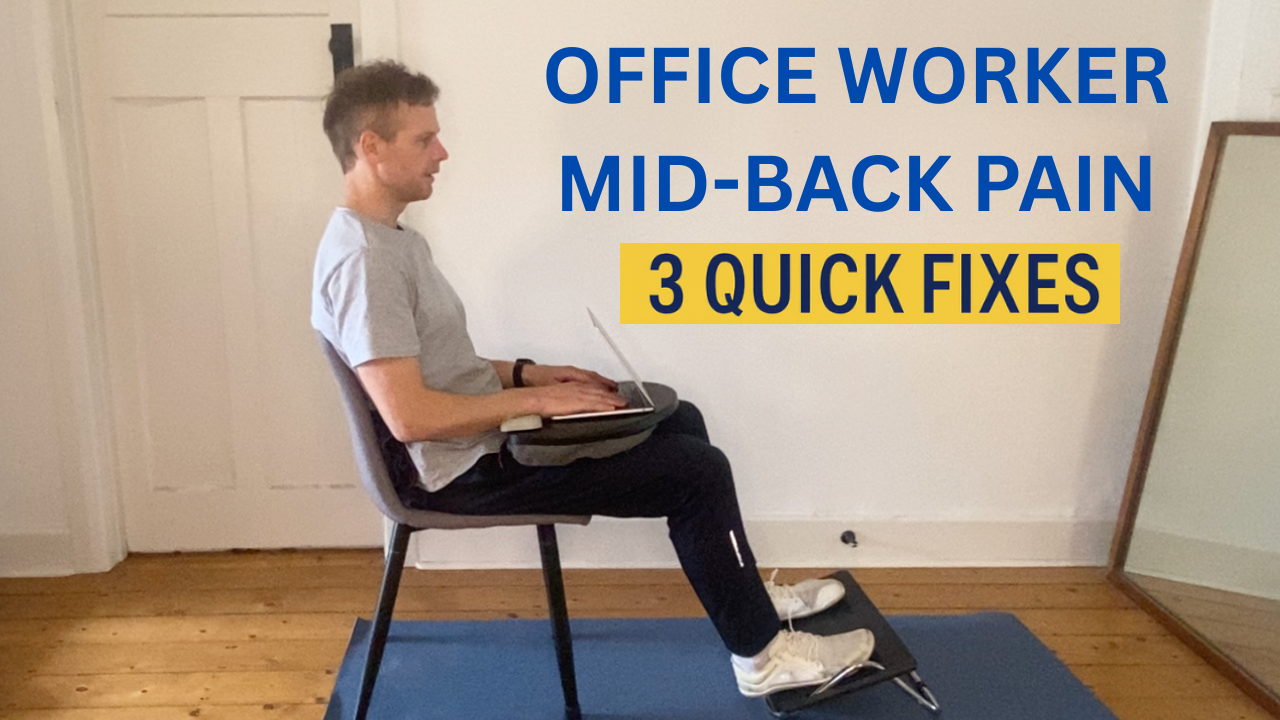Do you get that nagging ache between your shoulder blades—especially when you’ve been sitting at a desk all day or leaning over tools? That dull mid-back pain is often caused by weak muscles, poor posture, and strain that builds up gradually throughout the day. The good news is: you can do simple things today to reduce or even eliminate the ache.
Here are 3 things you can start doing now to relieve middle back pain and prevent it from coming back.
1. Strengthening Exercises: Snow Angels & Supermans
These exercises activate the muscles that support your upper/middle back—often the ones that get neglected.
Exercise 1: Snow Angels (lying down)
- Lie on your back with knees bent.
- Flatten your lower back against the floor (eliminate the gap).
- Hold your arms out at your sides, then slowly raise them over your head until they touch, then lower them back down.
- Keep your elbows and pinky fingers engaged, and keep your lower back flat throughout.
- Do 20 reps. Expect to feel your upper back (between shoulder blades) working hard. It’s normal to feel stretch through the chest too.
Exercise 2: Superman (prone position)
- Lie on your stomach, arms stretched out in front of you. Look forward.
- Lift your arms, chest, and legs off the ground simultaneously.
- Hold for ~15 seconds. Relax fully for 15 seconds.
- Repeat this 5 times.
- You should feel tension in your lower back, mid-back, and neck as you hold the position.
If these are intense, it’s okay. If you feel sore afterward, rest for 3-5 days before doing them again, then ease back in.
2. Improve Desk Ergonomics
If you sit at a desk for much of the day, your posture setup is critical.
- Foot Rest + Lumbar Support
Use a 45-degree footrest angled toward you. Push your feet lightly into it so some of your weight shifts toward the back of your chair.
Also, use a towel rolled up or a lumbar support pillow (inflatable or firm) placed behind your lower back at the apex of the lumbar curve. - Keyboard Distance
If your keyboard is too far away or you have to reach, you may hunch forward, which strains mid-back. Use a slide-out keyboard tray or bring the keyboard closer, possibly placing it on your lap or a tray beneath the desk if needed.
These changes help you maintain a more neutral spine, reducing strain to the muscles between your shoulder blades.
3. Decompression Breaks: Lie Down & Reset
Even with good posture and exercises, tension accumulates. Taking brief decompression breaks helps.
- Lie flat on your back on the floor for a few minutes, or lie on your side in a fetal position.
- If lying flat causes discomfort in the lower back, bend your knees or raise them slightly.
- Do this 2-4 times per day for 2-4 minutes per break.
- You can place a pillow between knees when lying on the side. Focus on relaxing shoulders and letting the spine decompress.
This simple reset helps release tension built from sitting and slouching, and lets your muscles rest.
Putting It All Together
Here’s how you might structure your day:
| Time | Activity |
| Morning start | Do Snow Angels & Supermans (20 reps / 5 holds) |
| Throughout work | Ensure you’re using footrest + lumbar support, and adjust keyboard distance |
| After lunch / mid-afternoon | Lie down for a decompression break (2-4 minutes) |
| End of day | Gentle stretch or repeat exercises if needed |
When to Be Cautious
If you experience any of the following, consult a health professional (chiropractor, physiotherapist, or GP):
- Sharp pain or numbness down arms
- Pain worsening despite doing these practices for more than 1-2 weeks
- Pain that wakes you at night
- Any tingling, pins & needles, or changes in strength
Why These Work
- Muscle activation: The exercises strengthen under-used muscles in the mid-back and upper back so they can better support posture.
- Ergonomics: Adjusting your sitting posture takes pressure off these muscles and reduces stretch/tension.
- Decompression: Gives your spine a rest, helps reduce tissue strain and lets your nervous system reset.
Conclusion
Middle back pain from sitting, hunching, or leaning doesn’t have to be your norm. By doing just three things—exercises, ergonomic fixes, and decompression breaks—you can reduce that dull ache, improve posture, and feel more comfortable throughout your day.
Give these methods a try. Let me know in the comments if you noticed a change or how you modified things for your setup. And if you’d like more personalised advice, I’d be happy to help.
About Andrew Cunningham
I’m a qualified chiropractor, personal trainer, and clinical Pilates instructor based at Advanced Health in Preston. I work with people every day to reduce pain, improve strength, and restore functional posture—whether from office work, sports, or daily life.
📍 4/107 Plenty Rd, Preston VIC 3072
📞 (03) 9484 9185
✉️ info@advanced-health.com.au
👉 Book Online: advanced-health.com.au/book-online






